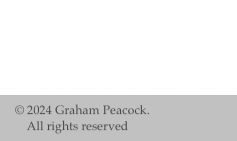|
Graham Peacock: Paint, Process and Spirit at the Edmonton Art Gallery
Lelde Muehlenbachs. ArtPost. Spring (1988)
A large, five-year retrospective of paintings by Graham Peacock at the Edmonton Art Gallery (November 21-January 16, 1988) is a mile? stone for Edmonton's abstract painting movement. Taking a bolder, more colourful route than many of his prairie colleagues, Peacock, like Frank Stella, shows just how far an artist can put himself out on a limb, jar the most seasoned viewers and make a mag?nificent visual contribution.
These heroic abstractions pack an encyclopedic amount of visual information, raw emotion and a quest for spirituality through colour. The installation itself, tightly hung by the Edmonton Art Gallery's new director, Roger Boulet, gives a sense of carnival-like totality, a by-product of so much visual stimuli. Originally from England, Peacock, a professor in the University of Alberta's Department of Fine Art, fully realizes what North American razzmatazz when it comes to colour can offer an intrepid, serious painter.
Putting informed bets on acrylic alchemy by developing his own gel over the last decade, Peacock discovered a way of drawing that created allover fields when paint dried, shrank, separated or crazed. The inclusion of these early pictures elucidates the route to the most radical works here.
To move beyond just crazing, Peacock now makes paintings by draping canvas into many large wooden troughs that fill his studio and pooling wet paint into wet, again and again. He liberally collages chunks of old camas, Styrofoam and plastic tubing to these surfaces. A host of surface textures emerge. Shorelines, cellular structures, Hawaiian pahoehoe lava and Landsat photographs are an impoverished list of what he conjures up.
Colour field, too mild a classification, gives way to colour topography. Peacock's clean, clear colour, acid hues, occasional metallics, strident colour relationships and idiosyncratic configurations often a result of the technical process, all effect a surprisingly wide expressive range.
Peacock is surely the most progressive picture-cropper around. His unconventional supports whether ovals, upside-dawn fear drops or odd geometric shapes arc cropped out of lengths of canvas a." a response to the visual dynamics occurring. These supports don't just echo a picture but add to the momentum set up by internal colour relationships. Frequently a private dialogue between frame and plane is suggested. One such work, the stately Starry Night titled after ?van Gogh's landscape, scents electrified with deep blues and blacks anti swirling textures. It's sparked by a powerful logic that can he discerned in spite of the clutter formal analysis might have. The beauty of Peacock's pictures lies in the tact they don't live up to conservative preconceptions.
While the most recent works return to traditional four sided formats they continue his inventiveness. Raw canvas edges become lyrical halos for the basic shape of a field.
Peacock's paintings can be as complicated as life itself. One comes away from this intense show grateful for being able to say, "why not?"
In December, two young talented painters Gerald Faulder and Mitch Smith turned part of their warehouse studio space in the Millar Building into an accessible temporary gallery, setting a welcome trend and providing a much needed alternative to conventional shows. They came off as their own best judges.
An abstractionist. Faultier also showed his watercolour landscapes, some darkly emphatic and executed with a Goodridge Roberts-type directness and assured freedom. Faultier exemplifies a seasonal tendency among several local, abstract painters to transform into plein-air realists in the summer. Like those of his colleagues, Faulder's landscapes have little to do with his ambitious abstractions. His slowly-wrought acrylics on paper contain intuitive drawing which plays hide anti seek with sprayed grounds in either muted or dayglow hues. These reflect ideas round in his lame abstractions of the past year. Faulder's gentle thoughtfulness really starts to pulse when he chooses to intensify his colours.
Much Smith tins superb collages thereby adding a fresh twist to the local scene. While Motherwell may lurk behind his sensibility 77e Little Canadian prison with its dripped vertical striations makes a direct reference to Motherwell's The Little Spanish Prison pf 1944 - Smith stays clear of the American master's refinement. Smith's work is marked by a poetic clarity that exists despite the rawness of pedestrian, found materials and the nonchalance and expressionistic, albeit responsive, paint handling.
Since hitting on the spontaneity of small collages during the Triangle Artists' Workshop, founded by Anthony Caro, in Pine Plains. New York in 1986- where he made brilliant use of paper towels - Smith has at last found a way to successfully merge collage with his major canvases. Until recently. these have depended on strong, lyrical drawing, a result of thinly-stained, overlapping veils in limited colours. In addition to corrugated cardboard anti stray papers. Smith also uses carpet underlay anti a flexible tin insulation wrapping that comes in a seductive turquoise blue.
|
|
|

